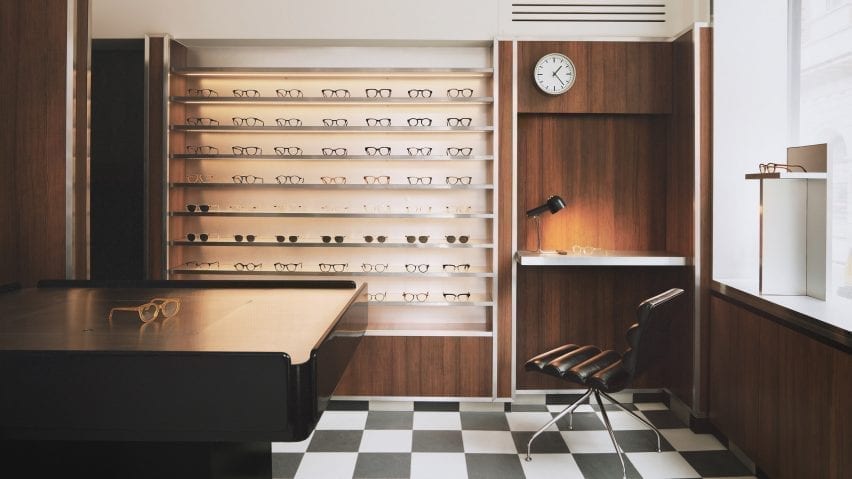Featuring linoleum floors, Formica walls and a deep red basement, this London eyewear store by Child Studio takes inspiration from peep shows and other "peculiar Soho specialities".
Perched on the corner of Marshall Street in London's Soho neighbourhood, the store for eyewear brand Cubitts occupies one of the early 19th-century buildings that line the area's narrow streets.
The store is spread out over a small ground floor and basement space lined by a narrow staircase.
In terms of practical requirements, the store needed to incorporate a display of the 100 different coloured acetate chips that customers can choose from to create bespoke frames.
London-based Child Studio designed the space to reflect the history of the area and create a customer journey that would encourage people to explore the basement.
"Cubitts wants each of its shops to have a unique design reflecting the history of the local neighbourhood," Child Studio co-founder Alexy Kos told Dezeen.
"The brand has a strong connection to London, where its glasses are made, and to modernism as the guiding principle to its design aesthetic."
To design the interior, the studio drew upon Soho's colourful reputation for massage parlours, adult cinemas and sex shops in the postwar era.
"Gambling, drinking, religious and political dissent, clubbing and prostitution were all, at varying times, peculiar Soho specialities," said the studio.
"We have focussed our research on Soho's heyday in the postwar era, looking at the interiors of the neighbourhood's iconic venues, such as the Formica-clad Bar Italia and the legendary jazz venue 100 Club, with its all-red interiors."
Referencing Soho peep-show booths, the store incorporates low partitions clad in a wood-effect Formica laminate and trimmed with aluminium to form a maze-like environment.
Display areas with illuminated acrylic shelving that showcase the spectacles and the colourful acetate chips are recessed into the walls. Lightbox signage integrated into the metal-trim cladding and black and white checkered linoleum flooring add to the store's nostalgic ambience.
An antique Caori cocktail table designed by Vico Magistretti in 1961 serves as a focal point on the ground floor.
Featuring a brushed aluminium tabletop and several concealed compartments for records and magazines, the piece was specially sourced by Child Studio and adapted to include a raised podium so that it is better serves the retail environment.
"Every project tells a unique story and we always look for rare and unusual furniture pieces to add depth and authenticity to the narrative," said the design team.
"The desk lamp is another mid-century find, created by the Czech designer Josef Hurka for the manufacturer Napako in the 1960s."
A narrow staircase leads to the basement, which is saturated in a deep red colour. Customers are guided to an eye examination room concealed behind a velvet curtain by neon signs.
Cubitt's moody basement lounge area is lit by the Conelight floor lamp by the British designer Ronald Homes and furnished with chrome and leather chairs designed by Giovanna Modonutti.
A collection of limited-edition sunglasses is displayed on illuminated shelves clad in aluminium-effect Formica that create a theatrical effect in the dark red surrounds.
Previously, the studio run by Kos and Che Huang has channelled the look of a 1950s cafe inside a vegan pizza restaurant in west London and transformed a former London post office into a sushi restaurant with a 1960s interior.
"We like to use the word 'cinematic' to describe the spaces designed by Child Studio," Kos told Dezeen. "With every project, we aim to capture a particular mood and atmosphere, rather than trying to recreate an interior from a specific era."
Photography is by Felix Speller and Child Studio.

